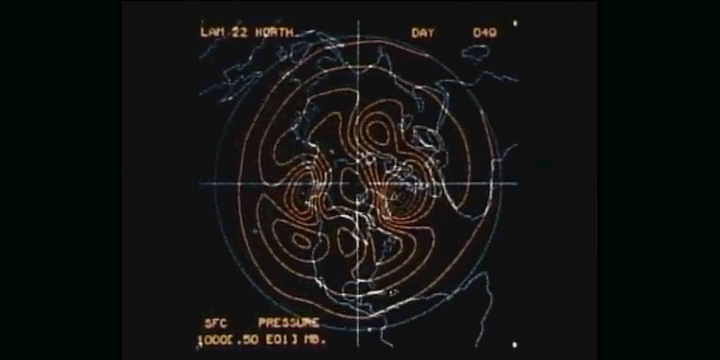News•May 19, 2015
Take a Look at One of the First Climate Models In Action

By Brian Kahn
Climate models, they just don’t make ‘em like they used to.
Of course, that may not be a bad thing. Like an Atari to an Xbox One, a Nokia brick to an iPhone 6, climate models have come a long way since their early predecessors. In a video recently published by Lawrence Livermore National Laboratory, you can see just how much of an update computer-run models have undergone from their humble beginnings in the 1950s.
Credit: Lawrence Livermore National Laboratory

The video shows one of the first global climate models ever created as it models weather in the northern hemisphere from a polar view. The grainy video and barely-there colors are a far cry from the splashy model outputs of today, but all the climate indicators you’d expect are there from the familiar — precipitation and high and low pressure systems — to the weather-nerd friendly — geopotential heights and atmospheric temperature.
Despite its simplicity, the visualization itself was no small feat. Chuck Leith, the physicist who created the model, spent time using cathode ray tubes (think back to TVs and computer monitors before the advent of flat screens) to translate the numerical information coming out of the model into something a little more engaging. In an interview with the Center for History of Physics, Leith said he worked with a Hollywood company that did movie credits to create the visualizations, which are some of the first climate and weather model visuals ever made.
And to complete the whole flashback, it’s worth considering the computing power itself. Leith’s model ran on one of the fastest computers of the day, the UNIVAC Livermore Advanced Research Computer (amazing retro photo alert). Of course what was fast in 1960 wouldn’t do you much good today: the iPhone 6 is literally a million times faster. And new computers and climate models are likely to come online in the next decade that will leave Leith’s model even further in the dust.
Don’t discount this oldie but a goodie, though. The physics in this and other early climate models inform our understanding of the planet today as well as the future impacts of climate change.
And while Leith’s model was eventually mothballed, other climate models hatched in the computing boom of the 1960s have continued to evolve and are still with us today. Efforts in the 1960s at the University of California, Los Angeles alone are responsible for eight climate models still in use today.
Given these feats and since the video above is silent, we figured “Praise You” would be a fitting listen.
You May Also Like:
Washington’s ‘Wet Drought’ Gets Worse
Canada Sets Goal to Cut Emissions by 2030
Heat is Piling Up in the Depths of the Indian Ocean
Climate Change May Put Power Grid at Risk in the West